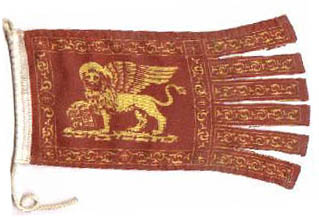 The Venetians, who
were already numerous and powerful on the island, acquired increased importance from the
fact that the sovereign was a Venetian and the adopted daughter of the republic. Their
pretensions were resented by the Cypriot nobility, who with the support of the Pope and
Ferdinand, the king of Naples, designed to place on the throne of Cyprus Alfonso, a
natural son of Ferdinand. The Latin archbishop, Fabricius, who was the leader of Alfonso's
party, arrived in Cyprus from Naples with two armed galleys and a letter from the Pope
denouncing the uncles of the queen as murderers of Jacques II. The conspirators broke into
the palace at Famagusta and, in the fracas which ensued, Andrea Cornaro and Marco Bembo
were killed. The Venetians, who
were already numerous and powerful on the island, acquired increased importance from the
fact that the sovereign was a Venetian and the adopted daughter of the republic. Their
pretensions were resented by the Cypriot nobility, who with the support of the Pope and
Ferdinand, the king of Naples, designed to place on the throne of Cyprus Alfonso, a
natural son of Ferdinand. The Latin archbishop, Fabricius, who was the leader of Alfonso's
party, arrived in Cyprus from Naples with two armed galleys and a letter from the Pope
denouncing the uncles of the queen as murderers of Jacques II. The conspirators broke into
the palace at Famagusta and, in the fracas which ensued, Andrea Cornaro and Marco Bembo
were killed.But the conspiracy was not supported
by the Cypriots, who had no desire to come under the rule of Naples. On the arrival of a
Venetian fleet at Famagusta to demand satisfaction for the murder of the uncles of the
queen, Fabricius and the other conspirators saw that their position was hopeless and
sought safety in flight. The republic of Venice was now in a position to pursue her own
schemes without any interference. The opportune death of the child, Jacques III, in 1474
removed the last legitimate heir to the throne. Venetian garrisons and commanders were
introduced into the fortresses of the island, and all those who were hostile to Venice or
likely to cause trouble, including the relations of the late king, were removed to Italy.
Caterina was allowed for fifteen years to remain queen of Cyprus, but she had no real
power, since all the principal offices of the kingdom were in the hands of the Venetians.
But, the position was not entirely satisfactory to Venice. Caterina was still young, and
there was a possibility of her marrying Alfonso, son of the king of Naples, and leaving an
heir to the throne. There was also a danger that the queen might rebel against her
Venetian advisers and regain authority over the island with the help of the Cypriots and
of the sultan of Egypt, her suzerain.
To guard against such contingencies, the republic
persuaded the queen to leave Cyprus. To compensate her for the loss of her throne, she was
allowed to retain the title of queen, with an ample allowance to enable her to live in a
manner befitting her rank.
 In 1489 Queen Caterina embarked for Venice, and remained in
honourable exile at Alonso for the remainder of her life. An ambassador was sent to the
sultan to announce that the republic of Venice had taken possession of Cyprus with the
free consent of the queen, and asked for a friendly alliance with Egypt.
In 1489 Queen Caterina embarked for Venice, and remained in
honourable exile at Alonso for the remainder of her life. An ambassador was sent to the
sultan to announce that the republic of Venice had taken possession of Cyprus with the
free consent of the queen, and asked for a friendly alliance with Egypt.
On 26 February 1489, the banner of St. Mark floated over
the castles and palaces of Cyprus and the Lusignan dynasty came to an end.
|